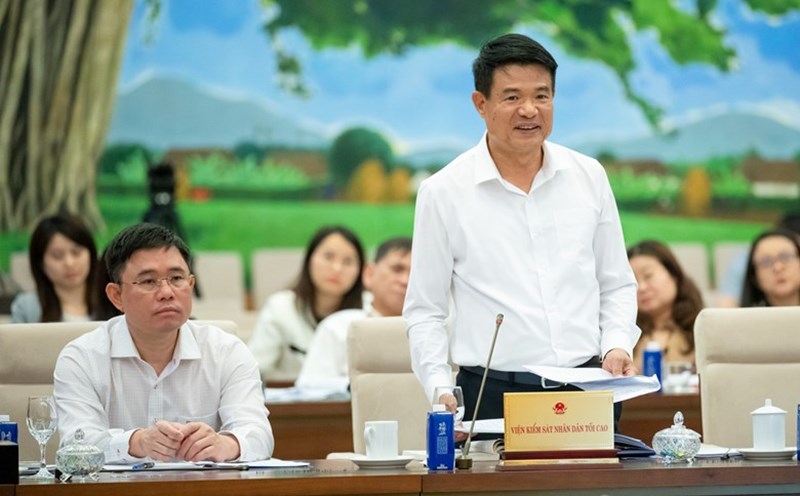Underground coal mapping
Party member Tran Danh Quan - born in 1988, head of drilling team 12, TKV Mining Geology Joint Stock Company, Cam Pha City, Quang Ninh Province - is a veteran geological driller in the coal industry.
He doesn't remember the exact drills that he and his colleagues have deployed to explore coal throughout the Quang Ninh coal region since entering the profession in 2009, but the emotions of finding coal deep underground, after months of eating and sleeping in the deep forest, soaking in the rain and sun, are still intact.
Because, with each successful drill, workers like him have contributed to drawing maps of reserves, stratigraphy, geology, physical properties, ash content, volatile matter, moisture, gas content and other parameters of minerals. Especially, with underground mining, understanding the geological structure helps avoid adverse phenomena underground.

Mr. Quan said, there are locations where initially we thought the coal reserves were only at a certain level, but unexpectedly, the coal reserves were so large and beautiful. At many drill points at a depth of -600m or less, there are coal seams that run for tens of meters, while currently, the deepest coal mining level in Quang Ninh is about -350m.
The work is hard and arduous, but as Quan shared, it is extremely attractive and exciting.
Each sample brought up from the ground adds to the hope of the coal mines that lie ahead. Drills continue to go deeper, through the lava layers, taking rock and coal samples to help clarify the stratigraphy.
“Our task is to drill to evaluate reserves, geological structure, stratigraphy, and related underground issues... Those parameters are the basis for the Vietnam National Coal and Mineral Industries Group (TKV) and coal mining companies to decide on mining plans and technologies to ensure efficiency and safety,” said team leader Quan.
Depending on the drill bit, but on average each drill bit lasts about 5-6 months.
The drilling process encountered many difficulties because the geological strata and underground geology were also very complex; not to mention the weather was sometimes very harsh, causing times when drilling down a meter was not possible for a whole week because of troubleshooting.
Depending on the terrain, decide whether to drill obliquely or straight, in which oblique drilling is always more difficult, longer and more expensive.
It is normal for drill bits to break deep underground and require stopping to handle the situation. Sometimes while drilling, a very strong water current suddenly comes up. In many sections where the geology is weak or muddy, dozens of tons of cement must be pumped down to solidify the surrounding area before drilling can continue.
Basically, all drills found coal, but some were unsuccessful, or the reserves were not large enough to be considered for future exploitation.
Record deep borehole
According to Mr. Ha Minh Tho - Director of Geological Joint Stock Company, the main unit of geological exploration drilling of TKV, after more than 65 years of construction and development, generations of drillers of the company have contributed and continue to contribute step by step to "awakening" the layers and coal seams deep underground.
The drill holes are getting deeper and deeper as required by TKV, in order to prepare for new coal mines when the reserves above are increasingly depleted. In the coal and mineral industry, exploration and survey drilling to establish new mines often have to be done at least 10 years in advance to cushion the coal mines that are about to run out of reserves.
The deepest coal exploration borehole in the country today is MK1227, also carried out by Mr. Quan's team 12 in 2023. This borehole is -1,320m deep, part of the Mao Khe coal mine exploration project, Dong Trieu.

The project has the task of exploring 25 coal seams, including designing a borehole to a depth of less than -1,000m to delineate, search and evaluate the potential of coal reserves below -600m to the bottom coal layer.
The project has a designed depth of -1,220m and is further extended to -1,320m to carry out the following tasks: studying stratigraphy, tectonics, determining the thickness and length of main coal seams; sampling coal chemistry, gas, coal ash chemistry and rock mechanics.
The location of the borehole is in a high, steep hilly area of Trang Luong commune, Dong Trieu city, Quang Ninh province. The geology here is very complex, the project is far from residential areas, far from water sources, construction is in an area with pressurized water, the stratum is thick, has large porosity, so it often causes complete loss of washing water, water intrusion, water spray... The clay layer has a thin layered structure, many local slip surfaces along the layer, poor bonding leads to swelling and strong collapse of the borehole wall.
According to experts, the construction of a borehole over -1,000m deep in the Quang Ninh coal basin often involves many risks, takes a lot of time and costs a lot of labor, materials and fuel.
However, after more than 5 months of construction, the MK1227 borehole was completed and ended at a depth of 1,320m, ensuring safety, productivity and quality goals. In particular, the borehole has determined the existence of coal seams and the resource prospect below -600m in the North wing of Mao Khe coal mine is relatively large.
(Posted on the special edition of Lao Dong Xuan At Ty)











